Saltzman B. (editor) Anomalous Atmospheric Flows and Blocking
Подождите немного. Документ загружается.

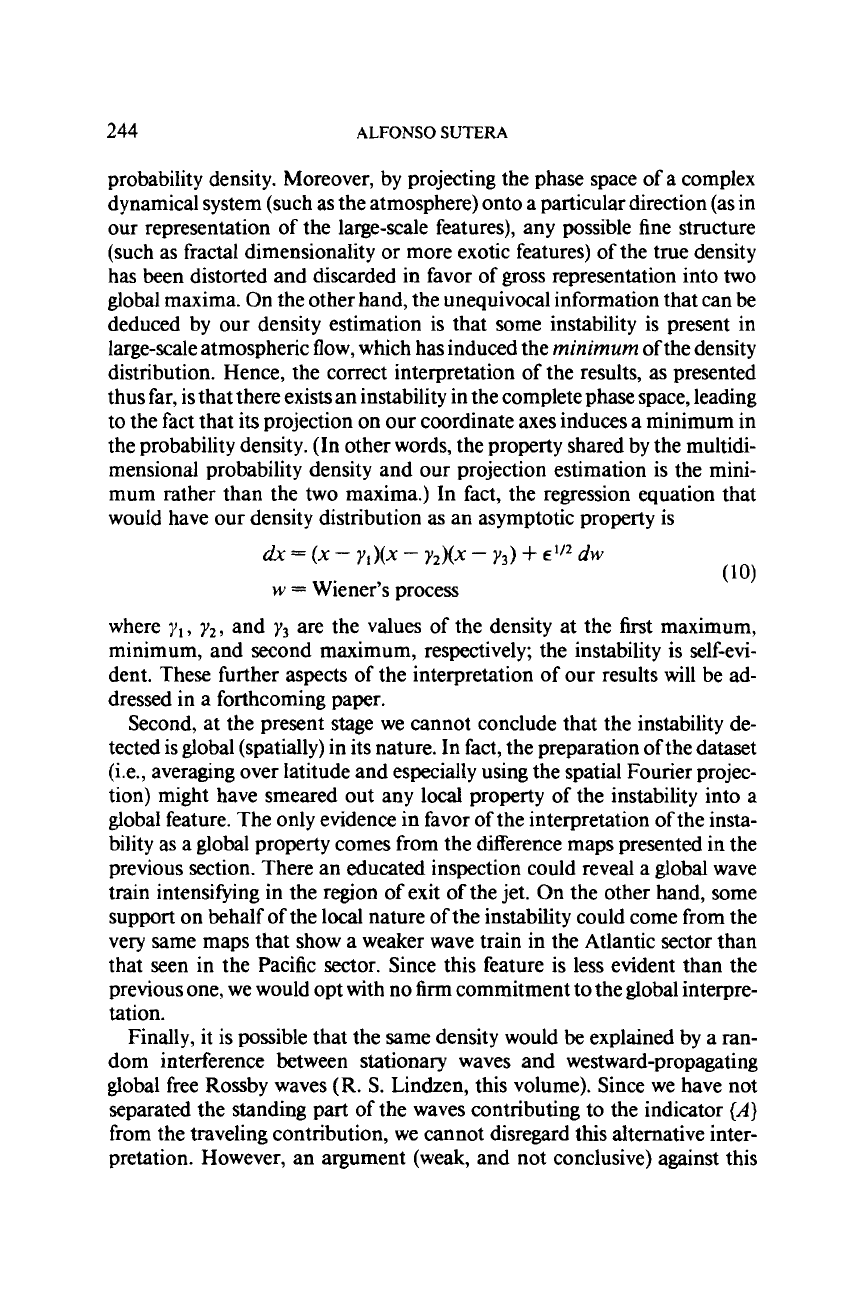
244
ALFONSO
SUTERA
probability density. Moreover, by projecting the phase space of a complex
dynamical system (such
as
the atmosphere) onto a particular direction (as in
our
representation of the large-scale features), any possible fine structure
(such as fractal dimensionality or more exotic features) of the true density
has been distorted and discarded in favor of gross representation into
two
global maxima. On the other hand, the unequivocal information that can be
deduced by our density estimation is that some instability is present in
large-scale atmospheric flow, which has induced the
minimum
ofthe density
distribution. Hence, the correct interpretation of the results, as presented
thus far, is that there exists an instability in the complete phase space, leading
to the fact that its projection
on
our coordinate axes induces a minimum in
the probability density. (In other words, the property shared by the multidi-
mensional probability density and our projection estimation
is
the mini-
mum rather than the two maxima.) In fact, the regression equation that
would have our density distribution
as
an asymptotic property is
du
=
(x
-
y,)(x
-
y,)(x
-
y3)
+
€1’2
dw
(10)
where
y,
,
yz,
and
y3
are the values of the density at the first maximum,
minimum, and second maximum, respectively; the instability is self-evi-
dent. These further aspects of the interpretation of our results will be ad-
dressed in a forthcoming paper.
Second, at the present stage we cannot conclude that the instability de-
tected is global (spatially) in its nature. In fact, the preparation of the dataset
fie., averaging over latitude and especially using the spatial Fourier projec-
tion) might have smeared out any local property of the instability into a
global feature. The only evidence in favor of the interpretation of the insta-
bility
as
a global property comes from the difference maps presented in the
previous section. There an educated inspection could reveal a global wave
train intensifLing
in
the region of exit of the jet. On the other hand, some
support on behalf of the local nature of the instability could come from the
very same maps that show a weaker wave train in the Atlantic sector than
that seen in the Pacific sector. Since this feature is less evident than the
previous one, we would opt with no firm commitment to the global interpre-
tation.
Finally, it is possible that the same density would be explained by a ran-
dom interference between stationary waves and westward-propagating
global free Rossby waves
(R.
S.
Lindzen, this volume). Since we have not
separated the standing part of the waves contributing to the indicator
(A}
from the traveling contribution, we cannot disregard this alternative inter-
pretation. However, an argument (weak, and not conclusive) against this
w
=
Wiener’s process
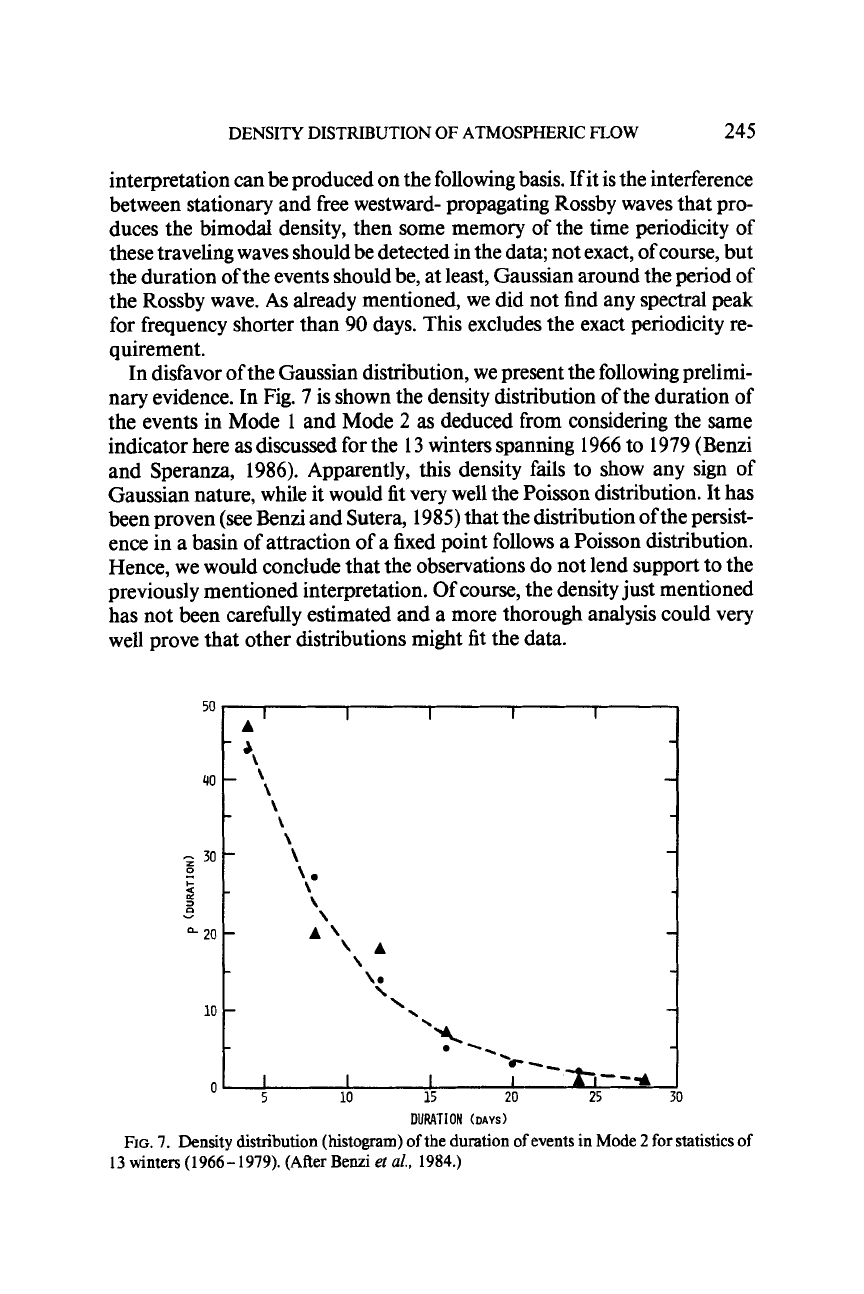
DENSITY DISTRIBUTION
OF
ATMOSPHERIC
FLOW
245
10
interpretation can be produced on the following basis. If it is the interference
between stationary and free westward- propagating Rossby waves that pro-
duces the bimodal density, then some memory of the time periodicity of
these traveling waves should be detected in the data; not exact, of course, but
the duration
of
the events should be, at least, Gaussian around the period
of
the Rossby wave. As already mentioned, we did not find any spectral peak
for frequency shorter than
90
days. This excludes the exact periodicity re-
quirement.
In disfavor of the Gaussian distribution, we present the following prelimi-
nary evidence. In Fig.
7
is shown the density distribution of the duration of
the events in Mode
1
and Mode
2
as
deduced from considering the same
indicator here
as
discussed for the
13
winters spanning
1966
to
1979
(Benzi
and Speranza,
1986).
Apparently, this density fails to show any sign of
Gaussian nature, while it would fit very well the Poisson distribution. It has
been proven (see Benzi and Sutera,
1985)
that the distribution of the persist-
ence in a basin of attraction
of
a fixed point follows a Poisson distribution.
Hence, we would conclude that the observations do not lend support to the
previously mentioned interpretation. Of course, the density just mentioned
has not been carefully estimated and a more thorough analysis could very
well prove that other distributions might fit the data.
-
\\
A
\a
\
-
-
\
-
'.
- -
5.
-\
*--
10
.
-
-
\\
A
\a
\
-
-
\
-
'.
-
5.
-\
*--
I
I
I
I
*I--*
DURATION
(DAYS)
FIG.
7.
Density distribution (histogram)
of
the
duration
of
events in Mode
2
for statistics
of
13
winters (1966-1979). (After Benzi
et
al.,
1984.)

246
ALFONSO
SUTERA
8. THE
ZONAL
WIND
As
mentioned in Section
2,
CDV
theory predicts that the zonal wind must
be
bimodal also. In the next section, using the same methods developed
so
far, we will address this question.
We present in Table
IV
the results of the density estimation for the variable
U.
In
Figs.
8a- 8d we present the corresponding densities that satisfy the
95%
confidence level.
It
is evident that no sign of bimodality is present in any of
the estimations considered. The density distributions are always unimodal
and strongly resemble Gaussian, slightly skewed density distributions. How-
ever, it appears that the skewness
of
the distribution varies from one year to
another. It implies that
if
we were to consider the distribution of the four
winters together, as we have done for the variable
A,
we might obtain a
spurious bimodal distribution. In fact, in this case, the correct interpretation
would be that the bimodal nature
of
the density is a consequence of the
interannual variability-i.e., of time scales much longer than the one here
considered (periods shorter than
90
days). Of course, this variation of the
zonal wind is
worthy
offurther investigation, and we hope to do it in the near
future with a larger sample. However, on the basis of the yearly individual
density, a regression equation, with such an asymptotic density deduced
from the data, is
(1
1)
where
p
is the decorrelation time for
U
(about
6
days). At the stationary state
(possible only if
E
were
0;
see Sutera,
198
1
for example) we will have
U
=
U*.
If we plot this relationship in the same phase plane of the
CDV
resonance
dU=
-j(U
-
U*)
dt
+
E’”
dw
TABLE
Iv.
CONFIDENCE
LEVELS
OF
THE
KOLMOGOROV-SMIRNOV
TEST
(pK)
FOR
lJa
RU
~~
(Y
1981 1982 1983 1984
0.1
X
lo4 0.9 0.99 0.98 0.99
0.4
X
lo3
0.8
0.96 0.94 0.99
0.1
X
lo3
0.7
0.8 0.8
0.75
0.6
X
lo2
0.55
0.7 0.5
0.3
0.2
X
lo2
0.5
0.5
0.2
0.005
0.1
X
lo2
0.4
0.3
0.07
0.015
0.4
X
10’
0.20
0.1
0.02 0.013
0.1
X
10’
0.05
0.05
0.002
0.005
0.6
X
100
0.03
0.01
O.OOO1
0.0008
a
The behavior
of
pK
as
a
function
of
the
hyper-
parameter
a
for
the
variable
U.
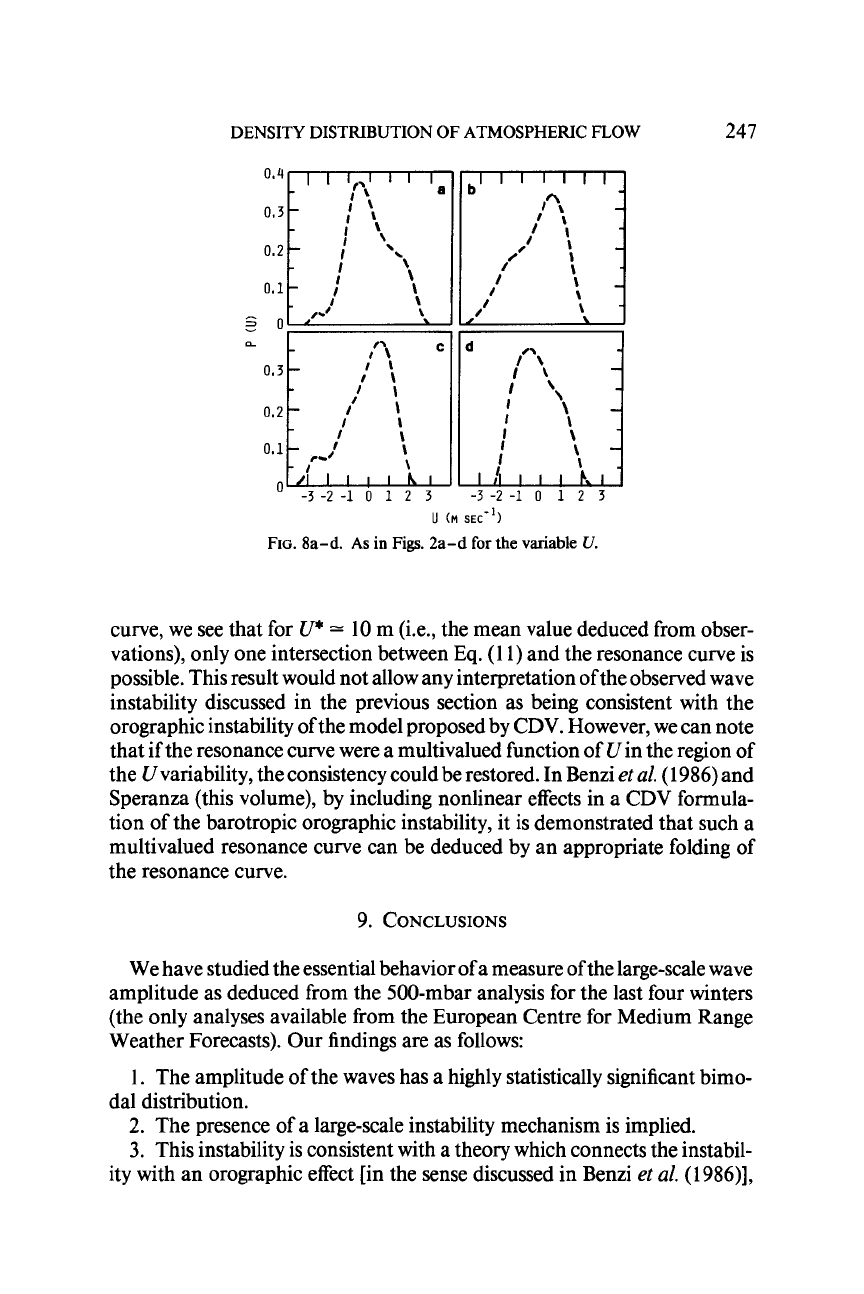
DENSITY
DISTRIBUTION
OF
ATMOSPHERIC
FLOW
247
0.4
0q3py
0.2
LOn3in.;
0.2
0.1
'
\
I-'
\
I
20
I
0.1
,,/
I
\
O
-3-2-1
0
12
3
U
FIG. 8a-d.
As
in
Figs.
2a-d
for
the
variable
U.
curve, we see that for
U*
=
10 m (i.e., the mean value deduced from obser-
vations), only one intersection between Eq. (1 1) and the resonance curve is
possible. This result would not allow any interpretation of the observed wave
instability discussed in the previous section
as
being consistent with the
orographic instability of the model proposed by CDV. However, we can note
that if the resonance curve were a multivalued function of Uin the region of
the Uvariability, the consistency could be restored. In Benzi
et
al.
(1986) and
Speranza (this volume), by including nonlinear effects in a CDV formula-
tion of the barotropic orographic instability, it is demonstrated that such a
multivalued resonance curve can be deduced by an appropriate folding of
the resonance curve.
9. CONCLUSIONS
We have studied the essential behavior ofa measure ofthe large-scale wave
amplitude as deduced from the 500-mbar analysis for the last four winters
(the only analyses available from the European Centre for Medium Range
Weather Forecasts). Our findings are as follows:
1.
The amplitude of the waves has a highly statistically significant bimo-
dal distribution.
2.
The presence of a large-scale instability mechanism is implied.
3.
This instability is consistent with a theory which connects the instabil-
ity with an orographic effect [in the sense discussed in Benzi
et
al.
(1986)],
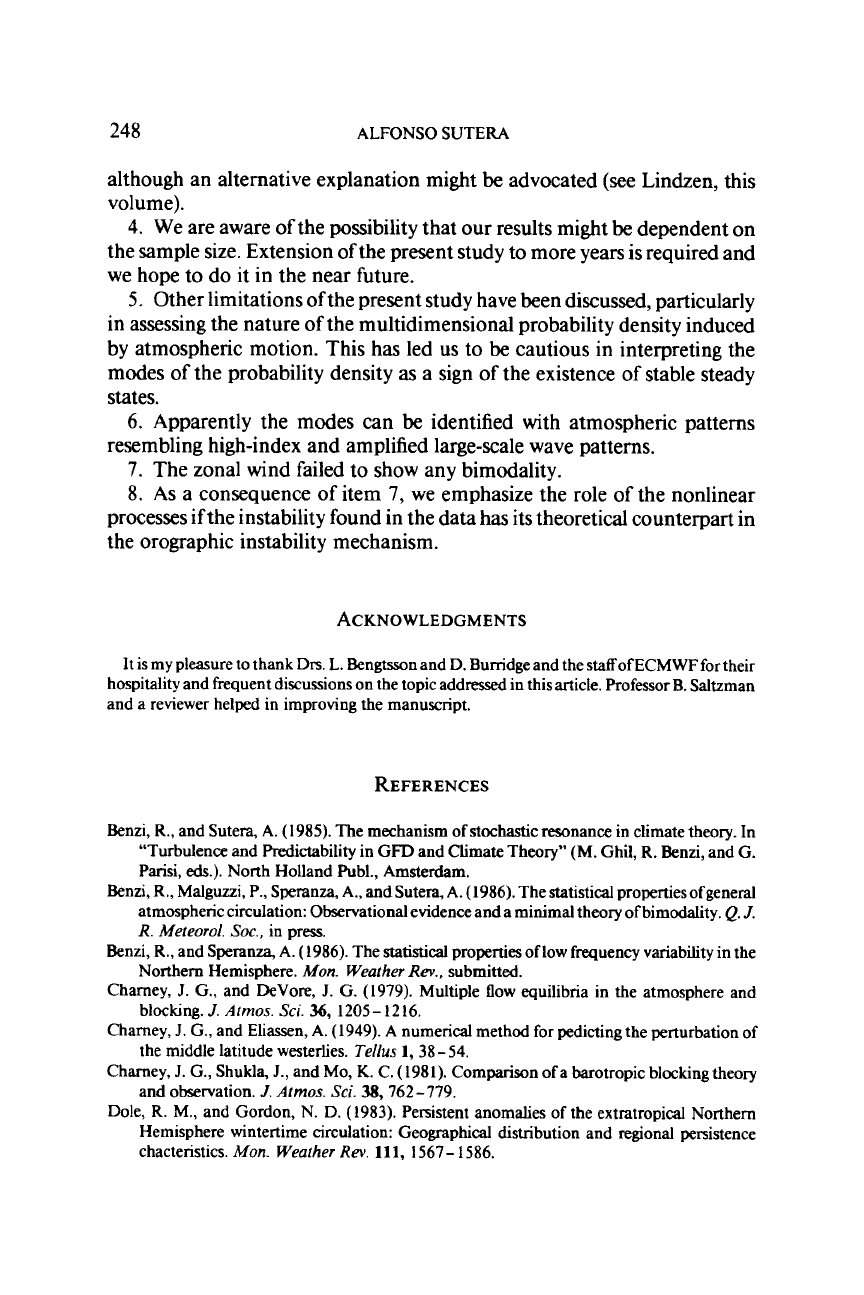
248
ALFONSO SUTERA
although an alternative explanation might be advocated (see Lindzen, this
volume).
4.
We are aware of the possibility that our results might
be
dependent on
the sample size. Extension of the present study to more years is required and
we hope to do it in the near future.
5.
Other limitations of the present study have been discussed, particularly
in assessing the nature of the multidimensional probability density induced
by atmospheric motion. This has led us to
be
cautious in interpreting the
modes of the probability density
as
a sign of the existence of stable steady
states.
6.
Apparently the modes can
be
identified with atmospheric patterns
resembling high-index and amplified large-scale wave patterns.
7.
The zonal wind failed to show any bimodality.
8.
As
a consequence of item
7,
we emphasize the role of the nonlinear
processes ifthe instability found in the data has its theoretical counterpart in
the orographic instability mechanism.
ACKNOWLEDGMENTS
It
is
my pleasure
to
thank
Dn.
L.
Bengtsson and
D.
Bumdge and the staff‘ofECMWFfor their
hospitality and frequent discussions on the topic addressed in this article. Professor B. Saltzman
and a reviewer helped in improving the manuscript.
REFERENCES
Benzi,
R.,
and Sutera,
A.
(1985).
The mechanism of stochastic resonance in climate theory. In
“Turbulence and Predictability in
GFD
and Climate Theory’’
(M.
Ghil,
R.
Benzi, and
G.
Parisi,
eds.).
North Holland Publ., Amsterdam.
Benzi,
R.,
Malguzzi,
P., Speranza,
A.,
and Sutera, A.
(1986).
The statistical propertiesofgeneral
atmospheric circulation: Observational evidence and a minimal theory ofbimodality.
Q.
J.
R.
Meteorol.
Soc.,
in press.
Benzi,
R.,
and
Speranza,
A.
(1986).
The
statistical
properties of
low
frequency variability in the
Northern Hemisphere.
Mon.
Weather
Rev.,
submitted.
Charney,
J.
G.,
and
DeVore,
J.
G.
(1979).
Multiple
flow
equilibria in the atmosphere and
blocking.
J.
Atmos.
Sci.
36,
1205
-
12 16.
Charney,
J.
G.,
and Eliassen,
A.
(1949).
A
numerical method for pedicting the perturbation of
the middle latitude westerlies.
Tellus
1,
38
-
54.
Charney,
J.
G.,
Shukla,
J.,
and
Mo,
K.
C.
(1981).
Comparison ofa barotropic blocking theory
and observation.
J.
Atmos.
Sci.
38,
762-779.
Dole,
R.
M.,
and Gordon,
N.
D.
(1983).
Persistent anomalies
of
the extratropical Northern
Hemisphere wintertime circulation: Geographical distribution and
regional
persistence
chacteristics.
Mon.
Weather
Rev
111,
1567- 1586.
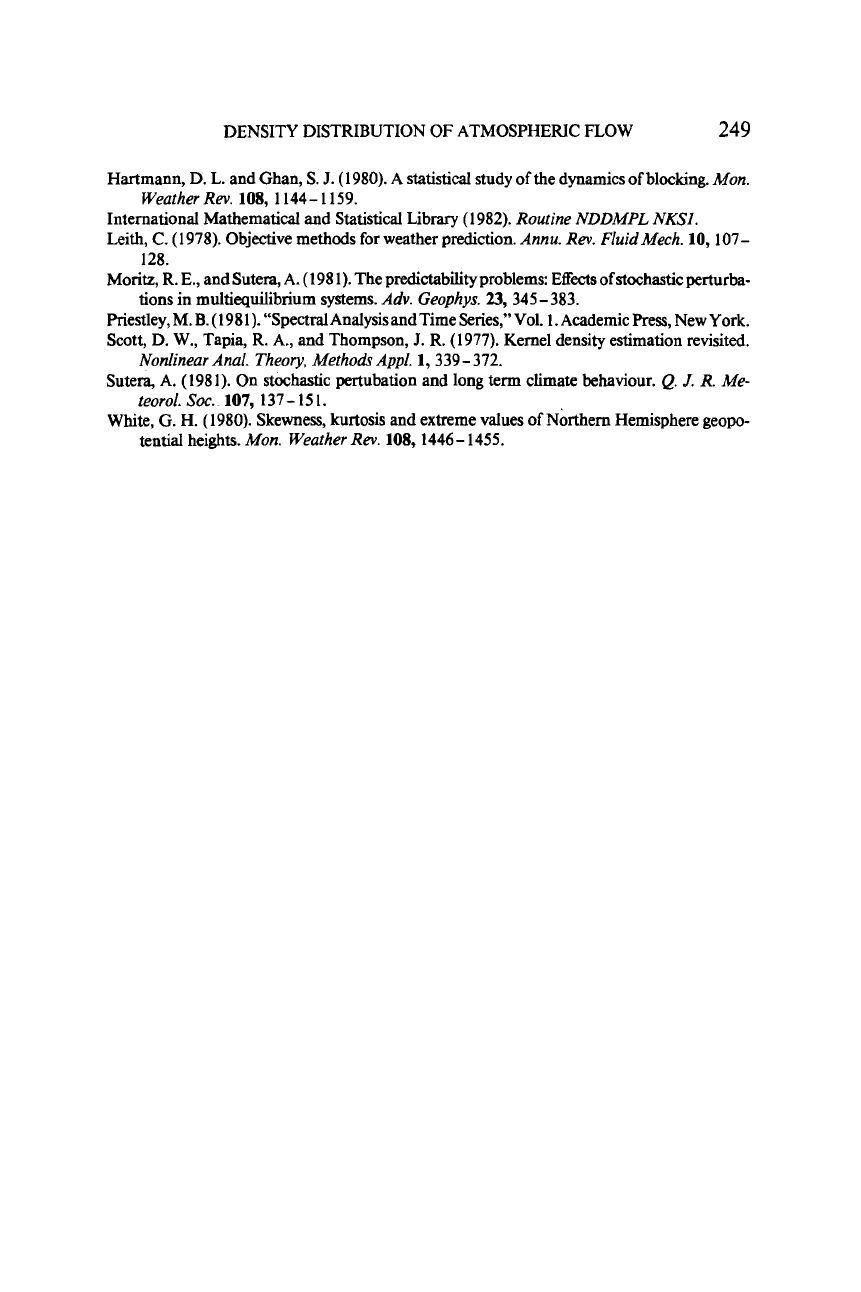
DENSITY DISTRIBUTION
OF
ATMOSPHERIC
FLOW
249
Hartmann,
D.
L. and Ghan,
S.
J.
(1
980).
A statistical study
of
the dynamics
of
blocking.
Mon.
International Mathematical and Statistical Library
(1982).
Routine
NDDMPL NKSI.
Leith,
C.
(1978).
Objective methods
for
weather prediction.
Annu.
Rev.
Fluid
Mech.
10,107-
Moritz,
R.
E.,
and Sutera,
A.
(198
1).
The predictability problems:
Effects
of
stochasticperturba-
Priestley, M.
B.
(
198
1).
“Spectral
Analysis
and Time Series,” Vol.
1.
Academic Press, New York.
Scott,
D.
W.,
Tapia, R. A., and Thompson,
J.
R.
(1977).
Kernel density estimation revisited.
Sutera,
A.
(1981).
On
stochastic pertubation and long term climate behaviour.
Q.
J.
R. Me-
White, G. H.
(1980).
Skewness, kurtosis and extreme values
of
Northern Hemisphere geopo-
Weather
Rev.
108,
1144- 1159.
128.
tions
in multiequilibrium systems.
Adv.
Geophys.
23,345
-
383.
Nonlinear Anal. Theory, Methods Appl.
1,339- 372.
teorol.
Soc.
107,
137-151.
tential heights.
Mon.
Weather
Rev.
108,1446- 1455.

This Page Intentionally Left Blank

STATIONARY PLANETARY WAVES,
BLOCKING, AND INTERANNUAL
VARIABILITY
R.
S.
LINDZEN
Center for Meteorology and Physical Oceanography
Massachusetts Institute
of
Technology
Cambridge, Massachusetts
021
39,
and
Physical Research Laboratory
Ahmedabad,
380
009,
India
1.
INTRODUCTION
This paper is a somewhat didactic discussion of various current trends in
the study of large-scale planetary waves and their anomalies. The intensity of
current activity on this topic stems from the belief that the anomalies can be
unusually long lived and may, therefore, represent particularly predictable
features of weather. The word “blocking” is sometimes associated with these
anomalies. Much of the present activity stems from the winter of 1976/ 1977,
when the period December to mid-February was, on the average, unusually
cold; this
was
associated with a stationary wave pattern that was significantly
amplified over its climatological mean (Namias, 1978).
It
seems to me that much of the current approach is unbalanced at best.
Far more work is being devoted to accounting for anomalies than to account-
ing for the climatology itself. Moreover, the contention that the anomalies
are persistent may itself be misleading.
By
persistence
I
suppose is meant
slow time variation compared to the expected periods of oscillation of the
atmosphere, Such persistence,
I
hope to show, accounts for a relatively small
part
of
the planetary-wave anomalies.
I
will begin, in Section
2,
by examining some aspects of the observed time
behavior of anomalies. It appears that there is some modest interannual
variability of stationary wave patterns, but little evidence of unusual persist-
ence in the larger anomalies. Indeed it appears that a significant part of
interannual variability is simply a statistical residue of short-period anoma-
lies.
Given the above conclusions, it is awkward to discuss the various explana-
tions put forward to account for the allegedly persistent anomalies. How-
ever, the observational picture is not yet convincingly clear. There is some
25
1
Copyright
0
1986
by
Academic
Press,
Inc.
All
rights
of
reproduction in
any
form
reserved.
ADVANCES
IN
GEOPHYSICS,
VOLUME
29
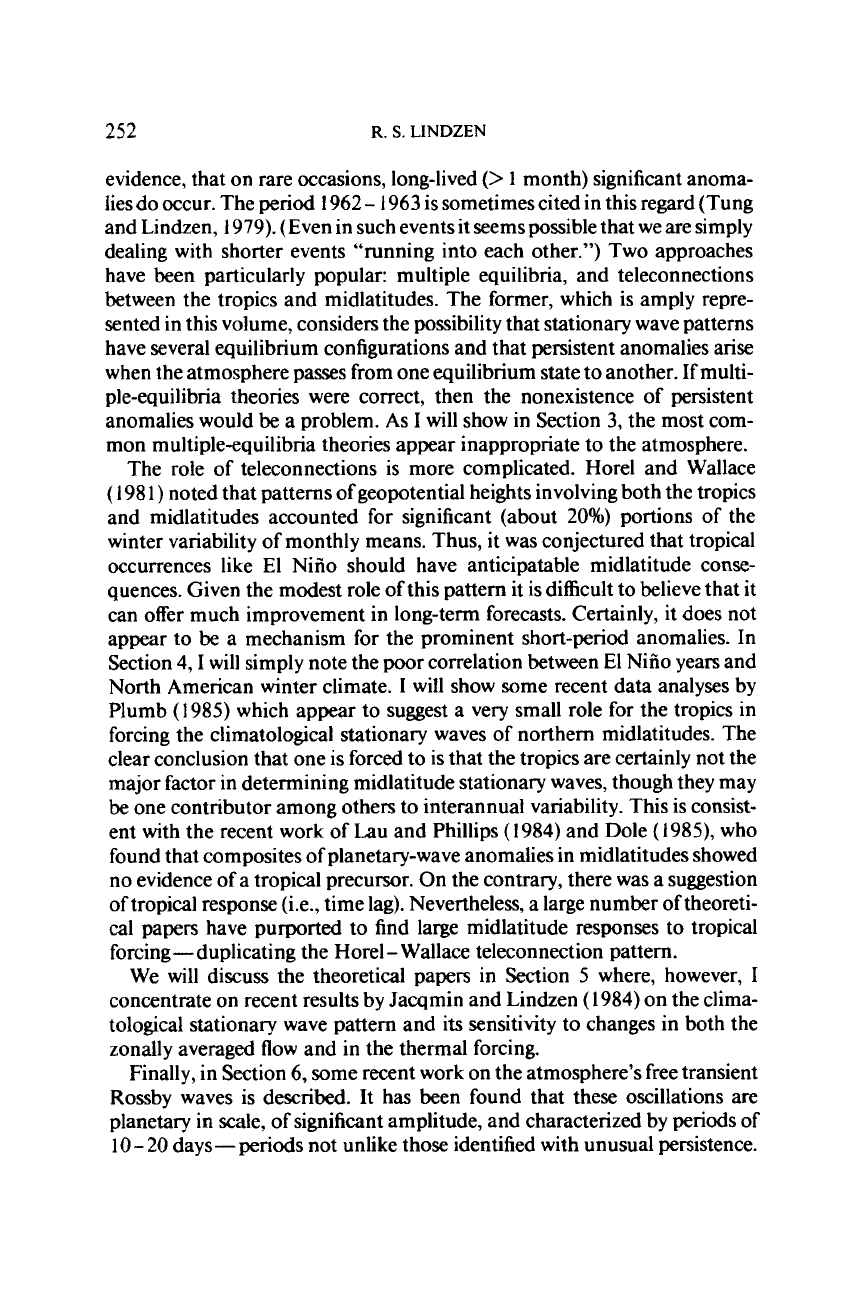
252
R.
S.
LINDZEN
evidence, that on rare occasions, long-lived
(>
1
month) significant anoma-
lies do occur. The period
1962
-
1963
is sometimes cited in this regard (Tung
and Lindzen,
1979).
(Even in such events it seems possible that we are simply
dealing with shorter events “running into each other.”) Two approaches
have been particularly popular: multiple equilibria, and teleconnections
between the tropics and midlatitudes. The former, which is amply repre-
sented in this volume, considers the possibility that stationary wave patterns
have several equilibrium configurations and that persistent anomalies arise
when the atmosphere passes from one equilibrium state to another.
If
multi-
ple-equilibria theories were correct, then the nonexistence of persistent
anomalies would be a problem. As
I
will
show in Section
3,
the most com-
mon multiple-equilibria theories appear inappropriate to the atmosphere.
The role
of
teleconnections
is
more complicated. Horel and Wallace
(
198
1)
noted that patterns of geopotential heights involving both the tropics
and midlatitudes accounted for significant (about
20%)
portions of the
winter variability
of
monthly means. Thus, it was conjectured that tropical
occurrences like
El
Niiio should have anticipatable midlatitude conse-
quences. Given the modest role of this pattern it
is
difficult to believe that it
can offer much improvement in long-term forecasts. Certainly, it does not
appear to be a mechanism for the prominent short-period anomalies. In
Section
4,
I
will simply note the poor correlation between El Niiio years and
North American winter climate.
I
will show some recent data analyses by
Plumb
(I
985)
which appear to suggest a very small role for the tropics in
forcing the climatological stationary waves
of
northern midlatitudes. The
clear conclusion that one is forced to is that the tropics are certainly not the
major factor in determining midlatitude stationary waves, though they may
be one contributor among others to interannual variability. This is consist-
ent with the recent work of
Lau
and Phillips
(1984)
and Dole
(1983,
who
found that composites
of
planetary-wave anomalies in midlatitudes showed
no evidence
of
a tropical precursor. On the contrary, there was a suggestion
of tropical response (i.e., time lag). Nevertheless, a large number of theoreti-
cal papers have purported to find large midlatitude responses to tropical
forcing-duplicating the Horel- Wallace teleconnection pattern.
We
will
discuss the theoretical papers in Section
5
where, however,
I
concentrate on recent results by Jacqmin and Lindzen
(1984)
on the clima-
tological stationary wave pattern and its sensitivity to changes in both the
zonally averaged flow and in the thermal forcing.
Finally, in Section
6,
some recent work on the atmosphere’s free transient
Rossby waves is described. It has been found that these oscillations are
planetary in scale, of significant amplitude, and characterized by periods of
10-
20
days
-
periods not unlike those identified with unusual persistence.
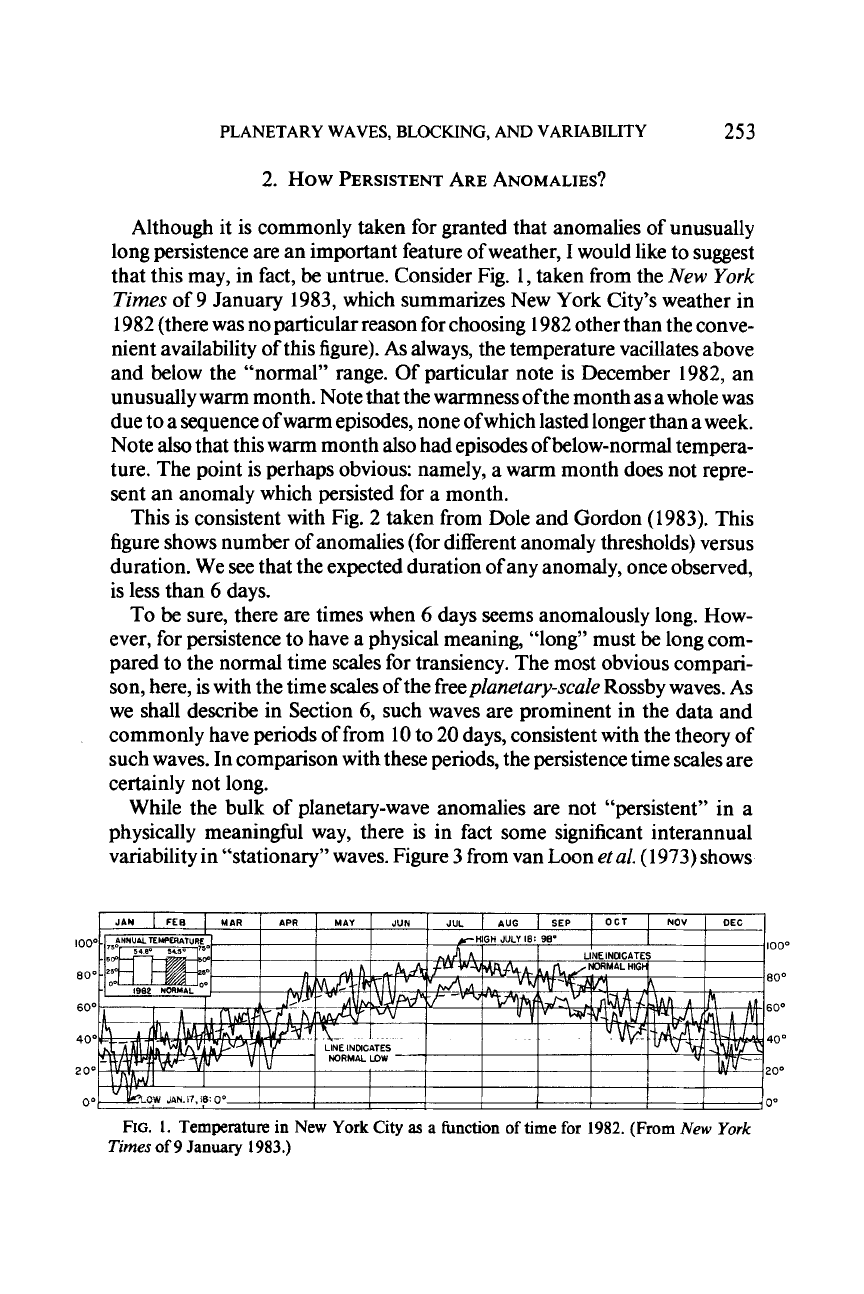
PLANETARY WAVES, BLOCKING, AND VARIABILITY
253
2.
How PERSISTENT ARE ANOMALIES?
Although it is commonly taken for granted that anomalies of unusually
long persistence are an important feature of weather,
I
would like to suggest
that this may, in fact, be untrue. Consider Fig.
1,
taken from the
New York
Times
of
9
January
1983,
which summarizes New York City’s weather in
1982
(there was no particular reason for choosing
1982
other than the conve-
nient availability of this figure).
As
always, the temperature vacillates above
and below the “normal” range. Of particular note is December
1982,
an
unusually warm month. Note that the warmness ofthe month
as
a whole was
due to a sequence of warm episodes, none of which lasted longer than a week.
Note also that this warm month also had episodes ofbelow-normal tempera-
ture. The point is perhaps obvious: namely, a warm month does not repre-
sent an anomaly which persisted for a month.
This is consistent with Fig.
2
taken from Dole and Gordon
(
1983).
This
figure shows number of anomalies (for different anomaly thresholds) versus
duration. We see that the expected duration of any anomaly, once observed,
is less than
6
days.
To be sure, there are times when
6
days seems anomalously long. How-
ever, for persistence to have a physical meaning, “long” must be long com-
pared to the normal time scales for transiency. The most obvious compari-
son, here, is with the time scales of the free
planetary-scale
Rossby waves. As
we shall describe in Section
6,
such waves are prominent in the data and
commonly have periods of from
10
to
20
days, consistent with the theory of
such waves. In comparison with these periods, the persistence time scales are
certainly not long.
While the bulk of planetary-wave anomalies are not “persistent” in
a
physically meaningful way, there is in fact some significant interannual
variability in “stationary” waves. Figure
3
from van Loon
et
aI.
(1973)
shows
1000
1000
800
800
60’
60’
40’
40’
2
00
200
00
FIG.
1.
Temperature
in
New York City
as
a
function
of
time
for
1982. (From
New
York
Times
of
9
January
1983.)
